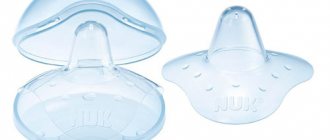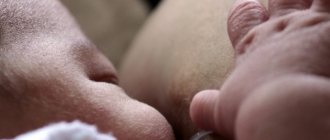The long 9 months of waiting to meet the baby are over! Childbirth is left behind, forever dividing our lives into “before” and “after”. How we waited for this opportunity - to look into the baby’s eyes, feel the smell of the top of his head, run our hand over his tender cheek! How much anxiety and trouble preceded this moment, how we prepared and hoped for a successful outcome of the birth...
We tried to organize the most worthy meeting for our treasure - exactly the one he dreamed of when deciding to crawl out of his mother’s cozy tummy. We decided that we would feed him with our milk. We want to give him the best start!
How does breastfeeding begin? Previous articles talked about (Ten steps to success, How to get your milk back) about preparing for feeding and the importance of correct positioning of the baby at the breast. Now let’s touch on the topic of the first hours and days after childbirth - what exactly it is advisable to do to establish successful lactation.
Technique for proper breastfeeding
To successfully establish lactation, you should follow the recommendations for feeding the baby on demand. That is, you need to put your baby to the breast when he shows the first signs of readiness for feeding. It is not difficult to understand that a newborn wants to attach to the breast. At this moment, he exhibits so-called searching behavior: he turns his head in search of the nipple, opens his mouth wide, pulls out his tongue, grunts and whimpers, and stuffs his fist into his mouth. Take your baby in your arms so that his head rests in the crook of your elbow.
This is the classic cradle position. Using her example, we will describe step-by-step instructions for correctly attaching a baby:
- Find a comfortable position. It is important to position yourself so that both mother and baby are comfortable, because the feeding process can last about an hour or longer. You can put a pillow under your back and elbow.
- Hold your baby so that his head and body are in line. Turn your face and stomach towards you.
- The baby's head should be positioned so that the nose rests on the nipple.
- Wrap your fingers around your breasts close to the areola. The thumb is located on top, the index and other fingers are located below the chest, parallel to the baby’s mouth. Squeeze the area around the nipple slightly to reduce the grip area.
- Touch your nipple to your baby's upper lip or cheek. In response, he will open his mouth wide and throw back his head to take the breast.
- Wait until the child opens his mouth as wide as possible and point the nipple slightly upward to the palate and at the same time press the child towards you, as if stringing his head onto the nipple. It is not the mother who should lean towards the baby’s head, but the baby who should reach for the nipple, opening his mouth wide and sticking out his tongue.
“In order for the baby to receive a normal amount of milk, correct capture of the nipple and most of the areola is important. The baby's mouth should be wide open. There is no milk in the nipple itself. Milk production occurs during stimulation of the areola."
Physiology of lactation
The entire physiology of lactation is based on the baby's sucking. I will write briefly, because... A lot of works and opinions have been written about this, they all boil down to one thing: no sucking - no milk. The more effective the sucking (this is just the correct attachment), the more often the breasts are emptied (frequency of attachments) - the more milk the mother has (the amount of milk). That's the trick. Mommies, don’t skimp on milk, don’t hesitate to feed more often, watch the latch, pay maximum attention to it at the very beginning, maintain it, and the physiology of lactation will interest you only for general development.
Criteria for correct application
If all the rules are followed, then the nipple is inside the mouth and does not participate in the sucking process. In this case, the mother does not experience acute pain during feeding.
Correct attachment during breastfeeding looks like this:
- The baby's mouth is wide open and covers the areola by 2-3 cm. The lips are turned outward, the chin touches the chest, the nose is free or leaning against the chest.
- The nipple is located deep inside the mouth and touches the roof of the mouth.
- While sucking, the baby actively moves his jaw, stimulating the areola, where the milk ducts are located. The tongue moves in waves, squeezing milk out of the nipple.
- Sometimes the mother can see the tongue between the lower lip and the areola.
- During feeding, the baby first makes quick and short jaw movements. And as milk comes in, it slows down. Sometimes he pauses.
- While sucking, your baby's ears may move a little. The cheeks are rounded.
Rules for successful natural breastfeeding
The preparation of the female breast for lactation occurs already during pregnancy. Colostrum is the first milk that a baby receives in the first 2-3 days of life. Colostrum helps create intestinal microflora and has a mild laxative effect - it cleanses the baby’s intestines of meconium (original feces). It is produced in small portions, but constantly.
Therefore, frequent latching of a newborn to the breast stimulates the mammary glands to produce milk in the required quantity. Early attachment of a newborn to the breast is the main condition for successful breastfeeding. Nowadays, it normally occurs 1-2 hours after birth.
Duration of feeding
The mother's breast satisfies the child's needs not only for nutrition. The newborn also applies to quench thirst, to establish contact with the mother, to relieve postpartum stress, and to satisfy the sucking reflex. Depending on the need at a particular moment, the baby can spend different amounts of time at the breast. If he wants to eat, he will suck vigorously for 15-20 minutes until he reaches the hindmilk. If you want to drink, the attachments are short; while sucking, the baby is distracted and often interrupted. Sometimes while sucking, the baby closes his eyes and sucks lazily, making only a few swallowing movements per minute.
Sometimes feeding can take 40 minutes or an hour. Do not worry that your nipples will be injured due to long and frequent feedings. If the attachment is correct, if the grip is deep, then the nipple is not damaged. And to be at the mother’s breast for as long as one wants is the need of a newborn child. And the mother cannot know exactly what problem the child is solving during the next feeding. Does he want to drink or eat, or maybe he just misses his mother or is scared? Let the baby set the duration of feedings.
If the mother feels pain during feeding, then most likely the baby has latched onto the breast incorrectly. You should stop, take the breast from the baby and apply it again. To remove the breast from the baby, you need to stop the sucking process. To do this, simply insert your little finger into the corner of your mouth and turn it slightly toward you. The baby will reflexively open his mouth and release the nipple.
Long-term feeding
Currently, more and more mothers are striving to breastfeed longer, understanding the importance of breastfeeding for the health and development of the baby. And this certainly makes me happy. But if you can read about the benefits of breast milk everywhere, even in a children’s clinic on a stand, then they don’t write so often about how to make breastfeeding for a long time and mothers have to look for this information. It's sad that not many people do this. Meanwhile, correct attachment is the primary condition for long-term and comfortable natural feeding .
From the consultant’s practice: the most common mistake, which, like a snowball, wraps itself around other problems, is the unreasonable introduction of the mixture in various variants. Most often, the reasons for introducing formula, according to mothers, are: “something is naughty, I’ll give the formula once,” “It’s okay if I supplement it at night so that I can sleep better,” “I need to leave, but I’ll pump for a long time, I’ll give it to you.” mixture while I’m away,” etc. The introduction of formula from a bottle, especially at an early age, with almost 100% probability reduces lactation, up to 1-2 months, beyond that only IV. At the very beginning of lactation, when the relationship with the breast is just being established, the introduction of formula is strictly not recommended. Unless, of course, this is dictated by medical indications: significant underweight (less than 125 grams per week), hypogalactia, separation from the mother and inability to feed expressed milk, etc.
Therefore, mothers who want to breastfeed longer, avoid supplementing their babies with formula unless absolutely necessary ! Monitor your latch, even if it seems to you that it is correct, it would be a good idea to make sure of this by reading articles, watching videos, and for greater confidence, by contacting a lactation consultant.
First application
The first breastfeeding, which usually occurs in the delivery room, immediately after the baby is born, has an important psychophysiological role.
If the birth took place safely and without the use of sedatives, a healthy baby behaves actively and is immediately ready for feeding. The baby instinctively crawls to the mother's breast and grabs the nipple. It often looks as if he spent his entire fetal life training to do this.
Putting a baby to the breast immediately after birth has a beneficial effect on establishing contact between mother and baby. And stimulation of the nipple promotes the production of large amounts of oxytocin, which leads to rapid passage of the placenta.
Perhaps, placing a baby on the mother’s breast in the first minutes after birth is the most emotional and memorable moment for mother and baby. Intrauterine life and nutrition through the placenta are over, now instinct leads the baby to the mother's breast. This is exactly what nature intended, and rightly so.
Transition from SV or IV to GV. Relactation
This topic has its own characteristics: in addition to knowledge, colossal patience and a great desire to breastfeed, the mother needs to know exactly why she is doing it. Different mothers have different goals. Yes - it's not easy; yes - it takes time: yes - you need a lot of patience: yes - a great desire. But those who overcame it never regretted it. Including me…
And here, correct attachment also does not remain aside... After a difficult stage, when in the most, at first glance, unusual ways, the child is again persuaded, motivated, in a word, seduced to take the breast and suck on it, comes the stage of teaching the baby to suck correctly. And it is thanks to correct latching on the breast and sucking that lactation regains its full strength, stimulation intensifies, and if everything is done correctly, then even adopted children are able to receive mother’s milk (you can’t hide your surprise!) And it’s amazing what maternal love and the female body can do .
How to care for your breasts
Often, young mothers make some mistakes in attaching their newborn at the beginning of feeding, and the nipples manage to crack or become inflamed. Therefore, painful sensations during feeding accompany women for some time. In order to cope with this problem, follow some recommendations:
- It is necessary to ensure that the baby grasps the nipple correctly. With a good attachment, the nipple is deep inside the baby's mouth and is not stimulated in any way. If applied correctly, cracked nipples will heal within a day or two.
- Wash your breasts only during your evening and morning showers, not more often. Washing the breast before and after feeding is an unnecessary procedure that washes away the protective layer of natural secretions and aggravates inflammation.
- You should not use soap and shower gel, as this dries the skin very much.
- Whenever possible, give your breasts air baths. This promotes rapid healing of the nipples.
- In particularly advanced cases, medicinal ointments containing lanolin can be used between feedings. But do this only after consulting a doctor.
“Nipples, pacifiers, and breast pads negatively affect the correct attachment of the baby to the mother’s breast. At first, until the baby has learned to suckle properly, they should not be used. During breastfeeding, the baby must actively move his jaws and tongue to get milk, and milk flows out of the nipple on its own, no effort is needed. Using a pacifier is often the reason for breast refusal.”
What to do if the baby does not want to breastfeed?
If your baby doesn't immediately want to eat, you don't need to worry. There is no need to force your baby to breastfeed. Perhaps he needs a little more time to rest. This happens after a difficult birth or cesarean section. In such a situation, calm and patience are necessary. The baby will rest and will definitely want to eat. The main thing is that before the baby receives your colostrum (breastfeeding), he does not receive anything else (formula or water from a bottle).











